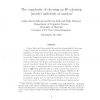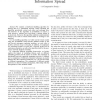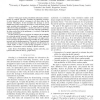580 search results - page 2 / 116 » Choosing a random peer |
STOC
2002
ACM
14 years 5 months ago
2002
ACM
Cooper, Dyer and Frieze studied the problem of sampling H-colourings (nearly) uniformly at random. Special cases of this problem include sampling colourings and independent sets a...
MCS
2010
Springer
13 years 7 months ago
2010
Springer
Abstract. Functional magnetic resonance imaging (fMRI) is a noninvasive and powerful method for analysis of the operational mechanisms of the brain. fMRI classification poses a sev...
QEST
2009
IEEE
14 years 1 days ago
2009
IEEE
—We consider a distributed shuffling algorithm for sharing data in a distributed network. Nodes executing the algorithm periodically contact each other and exchange data. The be...
FOCS
2006
IEEE
13 years 11 months ago
2006
IEEE
We consider the problems of Byzantine Agreement and Leader Election, where a constant fraction b < 1/3 of processors are controlled by a malicious adversary. The first problem...
ICC
2009
IEEE
14 years 1 days ago
2009
IEEE
Abstract—This paper studies probabilistic information dissemination in random networks. Consider the following scenario: A node intends to deliver a message to all other nodes in...



